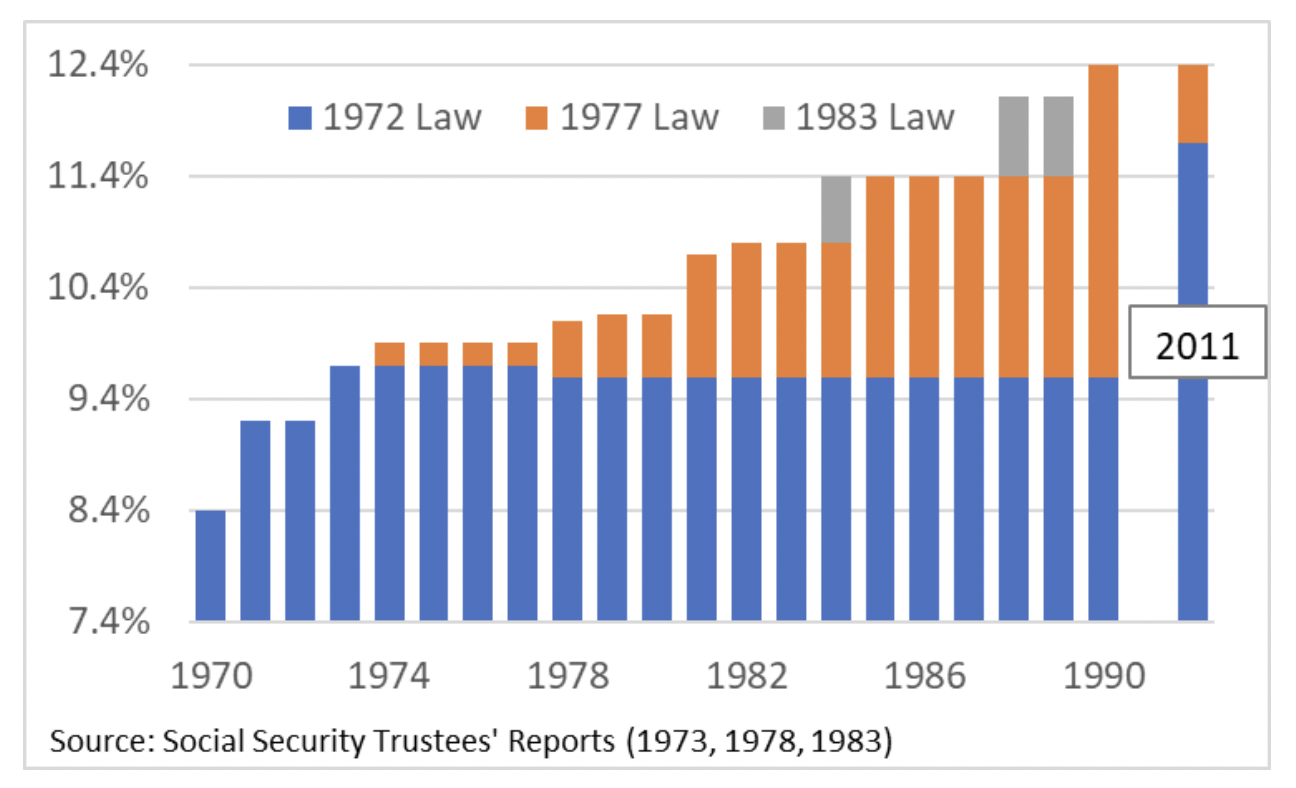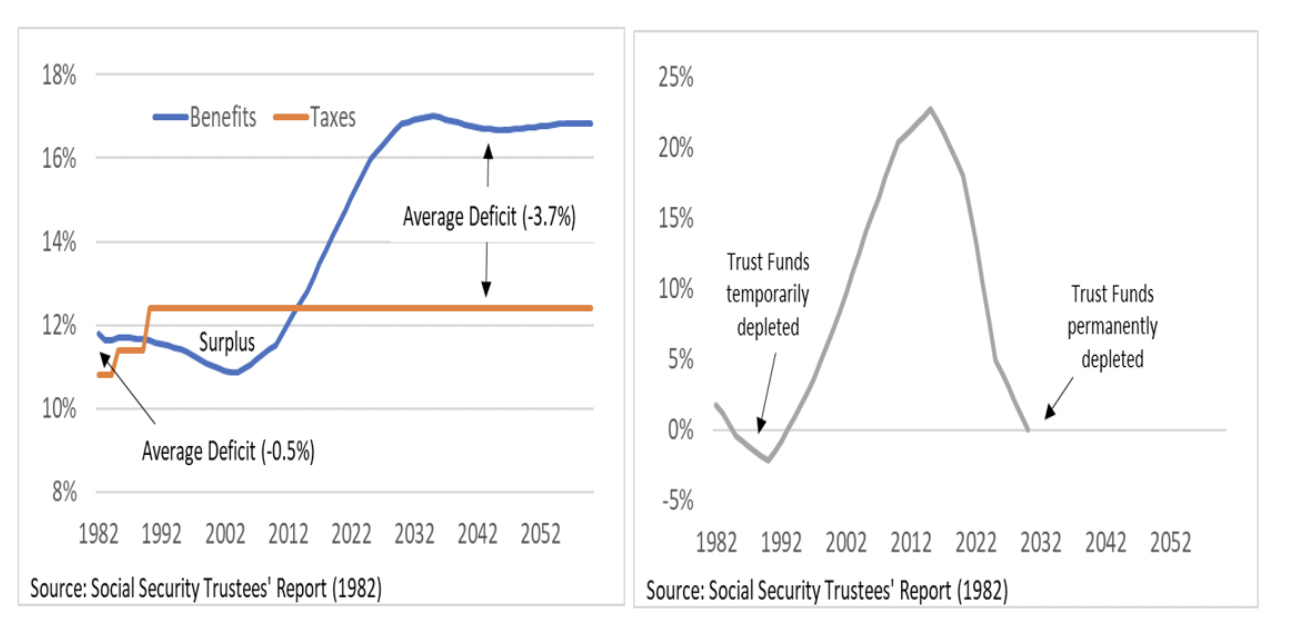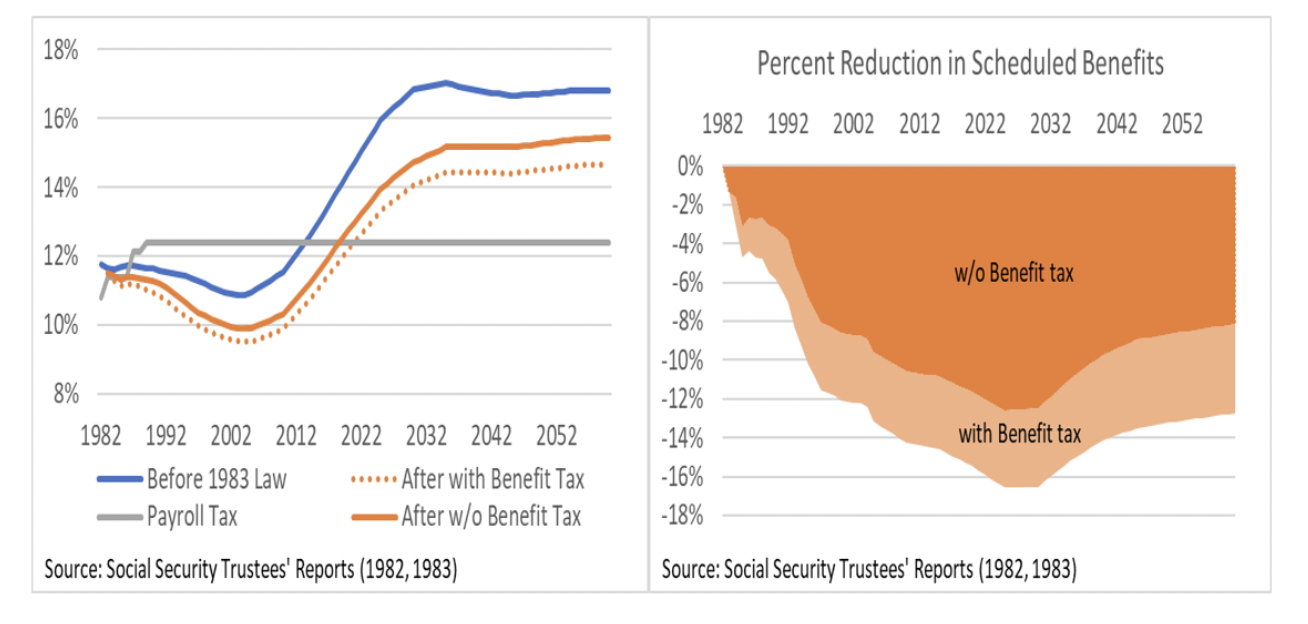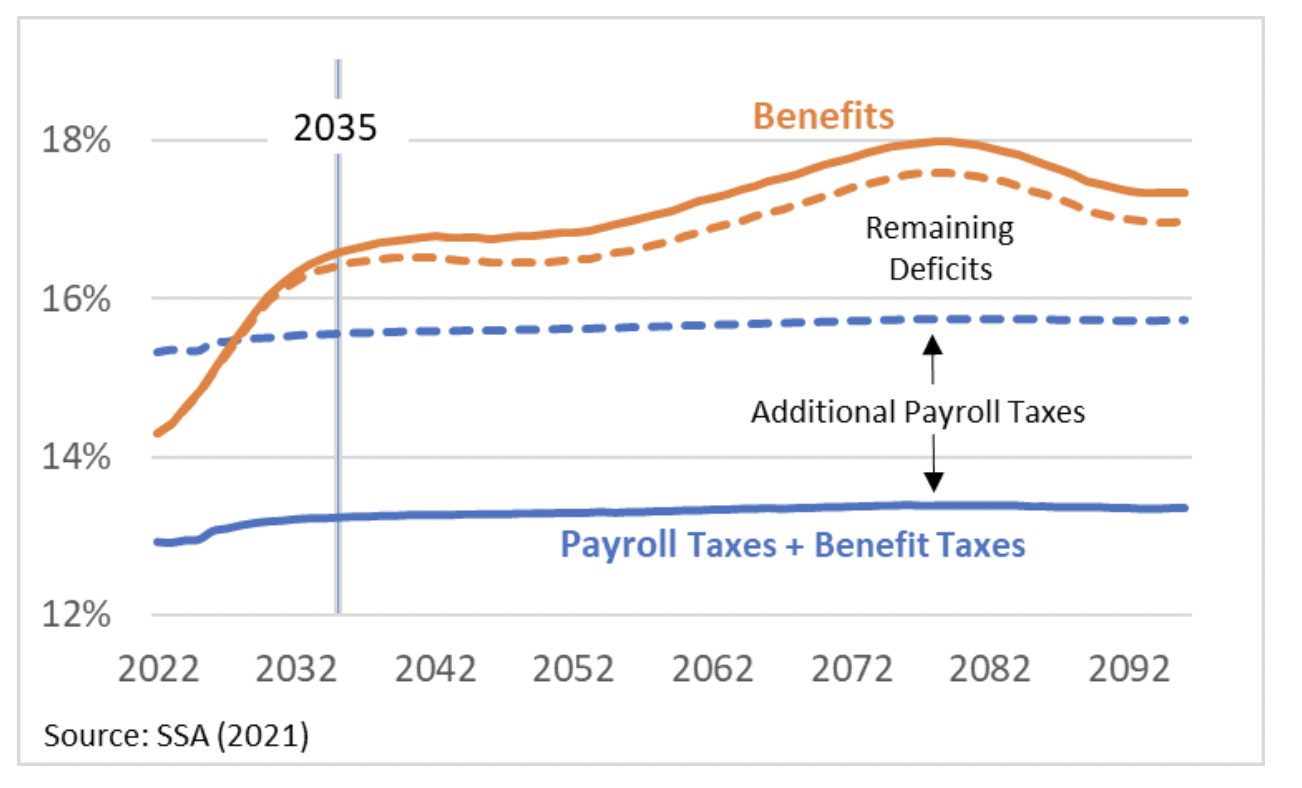Introduction
Since the last major Social Security reforms enacted in 1983, every annual Trustees’ report has projected benefits would exceed payroll taxes (plus income taxes on benefits) by 2021 or earlier, and the combined retirement and disability trust funds would be depleted between 2029 and 2063. In fact, benefits have exceeded taxes every year since 2010, and the projected depletion date has varied only slightly between 2033 and 2035 for the past decade.[1]
Despite nearly 40 years of advance notice, Congress has failed to divert Social Security from its projected path to insolvency, which will occur in 2035 according to the 2022 Trustees’ report. Once the trust funds are depleted, scheduled benefits can no longer be paid in full or on time. The Social Security Administration must either reduce benefits across-the-board by 20 percent, or wait until the trust funds collect sufficient payroll taxes to pay full benefits, meaning beneficiaries would receive only nine monthly benefit checks per year, instead of twelve.[2]
Many people seem to believe Congress can wait until the last minute to avert insolvency, just like it did in 1983. However, prospective policy changes that can be phased-in over time can no longer accomplish that goal if Congress waits until 2035 to implement them. Unless Congress is willing to increase payroll tax rates or reduce benefits across-the-board, it will have to use general revenue transfers instead to avoid trust fund depletion.
But the use of general revenue would break the historical link between benefits and taxable wages and undermine public perception that Social Security is an earned benefit, rather than welfare. It would also prevent the trust funds from serving as a useful indicator of future financial problems, and weaken the fiscal discipline they impose by preventing benefit payments in excess of their dedicated sources of revenue.
This issue brief will examine the differences between Social Security’s finances in the early 1980s and the early 2030s and consider why continued delay threatens Social Security’s tradition of being a self-financing program.
1980s vs 2030s
In 1972, Congress adopted a new benefit formula that had the unintended effect of automatically increasing benefits for newly eligible beneficiaries faster than average wages or consumer prices under certain economic conditions.[3] This flawed formula was replaced in 1977 and the payroll tax rate was scheduled to increase to an ultimate rate of 12.4% in 1990, instead of an ultimate rate of 11.7% in 2011 under the 1972 law.[4]
Figure 1: Social Security Payroll Tax Rates (1970 to 1990-2011 and After)

Unfortunately, benefits increased too much before the scheduled payroll tax rate increases took effect and the retirement trust fund had to borrow from the disability and Medicare trust funds to avoid insolvency in 1982. Although the scheduled tax increases were projected to restore trust fund solvency between 1993 and 2030, Congress accelerated the tax increases and enacted other changes in 1983 to avoid the temporary period of insolvency that was projected to occur between 1983 and 1993.[5] Figure 2 shows the projected financial status of the Social Security program in 1982 before enactment of the 1983 reforms.
Figure 2: Social Security Benefits, Taxes, and Trust Fund (Percent of Taxable Payroll)

Congress could have simply addressed the temporary shortfall caused by the delayed payroll tax increases and restored solvency through 2030. The average cash-flow deficit from 1982 to 1989 was 0.5 percent of taxable payroll, which was equivalent to 4.4 percent of scheduled benefits during that period.[6] Instead, Congress decided to make additional changes to eliminate the 75-year actuarial deficit, which was 1.82 percent of taxable payroll. That’s equivalent to an average benefit reduction of about 13 percent over the entire 75-year period.[7]
The additional changes included delaying annual cost-of-living adjustments (COLAs) from June to December; increasing the retirement age from 65 to 67, phased-in from 2000 to 2005 (65 to 66) and from 2017 to 2022 (66 to 67);[8] taxing up to 50 percent of Social Security benefits; and expanding coverage to nonprofit organizations and newly hired federal employees.[9]
The left side of Figure 3 shows the cost of scheduled benefits as a percentage of taxable payroll before and after the 1983 reforms, with and without the reduction from taxing benefits. The right side of Figure 3 shows how the reductions were gradually phased-in and did not exceed the average amount of 13 percent until 2005.
Figure 3: Social Security Before and After 1983 Reforms (Percent of Taxable Payroll)

The 1983 reforms were initially projected to achieve 75-year actuarial balance – i.e., trust fund solvency through the 2050s. But the reforms did not eliminate the annual cash-flow deficits projected to occur beyond 2021. Subsequent economic, demographic, and programmatic outcomes and assumptions moved the date of annual cash-flow deficits to 2010 and trust fund depletion to 2035 in the most recent Trustees’ report.[10]
Unlike the modest reforms in the early 1980s, avoiding trust fund insolvency starting in the early 2030s will require drastic measures. Between 2035 and the end of the current 75-year projection period in 2096, the average cash-flow deficit is 4.15 percent of taxable payroll; that’s more than twice the 1.82 percent actuarial deficit in 1982. (Note that in 1982 a cash-flow deficit and an actuarial deficit were mathematically equivalent.[11]) Waiting until 2035 to eliminate the cash-flow deficit would require a 24 percent reduction in scheduled benefits or a 34 percent increase in the scheduled payroll tax rate.[12] These changes would have to apply across-the-board beginning in 2035.
To put these changes into perspective, Figure 4 shows the additional payroll taxes (blue dashed line) that would be collected by eliminating the maximum limit on taxable wages (“tax max”) and subjecting all covered earnings to the full 12.4 percent payroll tax rate.[13] This projection assumes workers do not receive any benefits based on earnings above the tax max. It also assumes affected workers shift part of their compensation from taxable wages to tax-exempt fringe benefits, such as pensions and insurance, thereby reducing their Social Security benefits (orange dashed line).[14]
Figure 4: Eliminating Tax Max Will Not Eliminate Deficits (Percent of Taxable Payroll)

It is important to note that taxing more wages without providing more benefits represents a fundamental departure from Social Security’s tradition of linking benefits to taxable wages. But if Congress delays action until 2035, even this extreme policy would not prevent insolvency or eliminate future deficits. The remaining deficits from 2035 to 2096 would still be nearly as large as the 75-year actuarial deficit in 1982 (1.63 vs 1.82). Indeed, there are no prospective policy changes that could be phased-in after 2035 before the trust fund is depleted.[15] As a result, Congress will ultimately face the choice between raising payroll tax rates and cutting benefits across-the-board or using general revenue to maintain solvency.
The Path of Least Resistance
President Franklin Roosevelt reportedly said, “We put those payroll contributions there so as to give the contributors a legal, moral, and political right to collect their pensions and unemployment benefits. With those taxes in there, no damn politician can ever scrap my Social Security program.”[16]
Between 1935 and 1972, Congress generally maintained the Social Security program on a pay-as-you-go basis, with annual payroll taxes roughly covering the cost of annual benefits. This financing arrangement typically prevented Congress from increasing benefits more than they were willing to increase payroll taxes. But this modest level of fiscal discipline began to unravel with the reforms enacted in 1972.
Those reforms were based on the assumptions that average wages would increase nearly twice as fast as consumer prices, and birth rates would remain near baby-boom levels.[17] But the decade of the 1970s saw rising inflation and falling birth rates. Thus, it soon became apparent future benefits were no longer affordable at the scheduled payroll tax rate. Rather than adjust taxes and benefits to maintain pay-as-you-go financing, the 1977 and 1983 reforms assumed short-term surpluses would temporarily offset long-term deficits, until some future Congress permanently addressed the problem.
In theory, this offset could occur through the accumulation of trust fund reserves. By collecting surplus payroll taxes in the short-term, the trust fund could invest the surplus in government securities that would earn enough interest to offset the long-term deficits. But scheduled payroll tax rates have never been high enough to accumulate a trust fund balance large enough to be sustainably solvent. This theory also ignores the question of where the government will get the money needed to pay the interest owed to the trust fund.[18]
So long as Congress remains reluctant to increase payroll taxes or reduce benefits enough to achieve sustainable solvency, it will have an incentive to engage in trust fund accounting gimmicks. While the prospect of Congress crediting the trust funds with massive amounts of general revenue might seem remote, there is ample precedent.
In 1983, Congress credited nearly $20 billion to the trust funds to offset the cost of “noncontributory” benefits for U.S. military personnel.[19] In 2011 and 2012, Congress credited more than $200 billion to the trust funds to offset the cost of temporarily reducing the payroll tax rate by two percentage points.[20] In both cases, Social Security received credit for payroll taxes that were never collected.
Figure 5: General Revenue Transfers for Military-Service Wage Credits (May 20, 1983)

It doesn’t take much imagination to dream up more reasons to credit the trust funds with additional government securities. For example, in 1999 President Clinton proposed to credit the trust funds with a portion of the projected surpluses in the federal budget.[21]
Alternatively, previous generations of beneficiaries received more than they contributed. For example, Ida May Fuller, the first monthly retirement beneficiary, received nearly $23,000 in benefits after contributing less than $25 in payroll taxes.[22] Some economists have deemed the diminished trust fund balance resulting from the payment of unfunded benefits as a “legacy debt” that should be repaid with general revenue.[23]
Regardless of the justification, the use of general revenue to maintain trust fund solvency would break the historical link between benefits and taxable wages and undermine the public perception that Social Security is an earned benefit, rather than welfare. Historically, welfare programs have been subject to a “means-test” that restricts benefits to lower-income individuals. Relying on general revenues would weaken public support for Social Security and jeopardize future benefits.
Conclusion
Despite the impending depletion of the Social Security trust funds, public opposition to increasing payroll taxes or reducing benefits has resulted in political gridlock preventing Congress from taking timely and constructive action. As a result, the path of least resistance leads to the use of general revenue transfers to prevent trust fund insolvency. But if Congress abandons the traditional link between benefits and taxable wages, Social Security is at risk of becoming just another welfare program. Prompt legislative action is required to avoid this result.
[1] RL33028 (congress.gov) Table A1; 1983TR.pdf (ssa.gov) Table 32, Alternative II-B; 1984TR.pdf (ssa.gov) Table 33, Alternative 11-B; and Concord Coalition calculations
[3] Financing Social Security: Issues for the Short and Long Term (cbo.gov)
[4] Reports from the Board of Trustees (ssa.gov)
[5] 1982TR.pdf (ssa.gov) Table 32, Alternative II-B
[6] 1982TR.pdf (ssa.gov) Table 27, Alternative II-B
[8] The retirement age increases occurred at a rate of 2 months per year for those who turned 62 in the specified years.
[9] Social Security Amendments of 1983: Legislative History and Summary of Provisions (ssa.gov)
[10] Reports from the Board of Trustees (ssa.gov)
[11] In 1982, the Trustees’ determined the actuarial balance on an “average-cost” basis, which reflects the 75-year average non-interest income and expenditures measured as a percentage of taxable payroll. Since 1988, the Trustees have determined the actuarial balance on a “level-financing” basis which reflects the present value of non-interest income and expenditures discounted by the trust fund interest rate. See 1988TR.pdf (ssa.gov) pp. 30-32
[12] The benefit reduction would need to be slightly larger [1/(1-t)] to offset the corresponding reduction in income taxes – i.e., lower benefits mean less income taxes will be paid on benefits.
[13] Long Range Solvency Provisions (ssa.gov); The tax max is $147,000 in 2022.
[14] Increase the Maximum Taxable Earnings for the Social Security Payroll Tax (cbo.gov); These projections do not include any reduction in the income taxes that are not earmarked to the Social Security program.
[15] Individual Changes Modifying Social Security (ssa.gov)
[16] The End of Social Security Self-Financing (mercatus.org)
[17] 1973TR.pdf (ssa.gov)
[18] Social Security and the Federal Budget | Concord Coalition
[19] 1984TR.pdf (ssa.gov), page 16
[20] Social Security: Temporary Payroll Tax Reduction (congress.gov); Trust Fund Data (ssa.gov)
[21] T-AIMD/HEHS-99-95 Social Security and Surpluses: GAO’s Perspective on the President’s Proposals
Continue Reading






